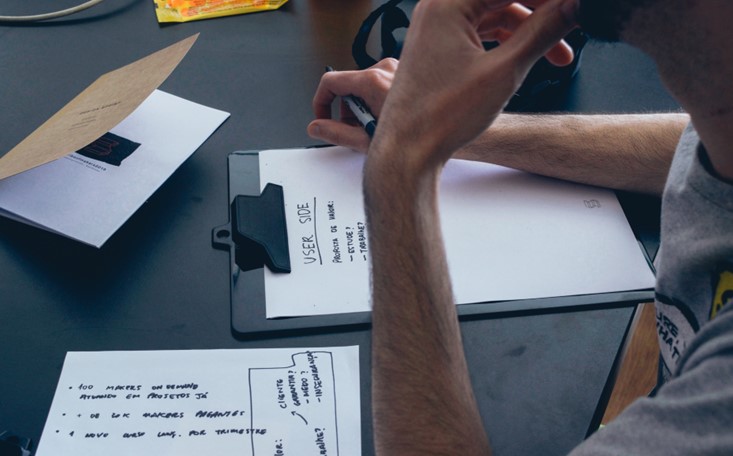The majority of articles discussing the communication and collaboration conducted by Business Analyst focus on the client and the development team. And rightly so, as it is a very important area of our work. However, in our environment, there is usually a player with whom I personally have had the opportunity to work with in almost every project I have participated in, and not much is said about the relationship with that person – the UX/UI designer.
Yet, especially in the initial stages of a project, BAs and UX/UI designers spend a lot of time together, exchanging information and insights that can change the course of the entire system concept they are creating. Therefore, I would like to consider how the collaboration and communication between these two roles should look like, in order to make it as effective as possible.
Who is UX/UI?
Before we get to the heart of the matter, let me briefly summarize what a person with the role of UX/UI designer does. Although the terms UI and UX are often used together or even interchangeably, there is a difference between these areas.
A UI designer focuses on creating visually appealing interfaces for websites, mobile and desktop applications. They work on subjects such as color schemes, typography, buttons, icons, and the layout of interface elements to create the proper visual hierarchy. All of this is aimed at intuitively guiding the user through the system’s features.
On the other hand, a UX designer focuses on the overall user experience and their interaction with the product. His goal is to create a seamless and enjoyable experience with the application. A UX designer conducts user research, creates user personas, develops wireframes and prototypes, and conducts usability tests to ensure that the product meets the needs and expectations of users.
Many companies combine these areas into a single role called UX/UI designer, who collaborates with the development team to achieve a common goal. Similarly, to Business Analyst, the role of the person responsible for UX/UI is not explicitly defined in Scrum, and how it is treated may vary depending on the organization and project needs.
However, it is most often a separate role, and the person in this role is often assigned to multiple projects at the same time in order to split their time between more and less demanding applications.
If the time and attention of the other person are divided among more than one project, it is the first strong argument for us to pay attention to efficient communication.
7 steps to successful collaboration
So, how can we collaborate to quickly and smoothly achieve a common goal (i.e. the best user-friendly product)?
Collaborating from the very beginning of the project
If we have the influence to involve both parties in the early stages of the project, let’s do it! Let’s take a moment to cooperatively define the action plan and the scope of our responsibilities (if we are unsure how to do it, we should ask the project manager for help). We need to focus on open communication, and understanding the project goals, business requirements, initial user needs and problems before moving on to the next phase of work.
Sharing knowledge and experience
BAs and UX/UI designers often have a wealth of experience in various business domains and with different types of users. BAs can provide context regarding business goals and constraints to better understand user needs and predict their behaviour, while UX/UI designers provide best practices and design trends.
Common front – the user
Both roles should support a user-centered approach – prioritize the user’s perspective and advocate for a needs-driven approach. It is of great value to involve both roles in user research sessions and consider the results in the requirements and prototypes.
Involving other people
The fact that cooperation between BA and UX/UI Designer requires a lot of time spent together does not mean that some meetings cannot be attended by others. Together we can identify areas where we need support, e.g., people with technical knowledge. At each stage of interface design, let’s remember that it cannot be created in isolation from the technologies used.
If we see such a need – let’s conduct common workshops, and meetings with stakeholders and/or the development team to adjust the project’s requirements, decisions and priorities, and our own ideas.
Collaborating on mockups and prototypes
The BA provides input in the form of functional requirements and ensures the designer’s understanding of them on an ongoing basis. Also, the Business Analyst is often the first reviewer of prepared mockups. The UI/UX designer focuses on usability and visual design aspects. Initial meetings may be based only on rough outlines of the target interface (wireframing), but they should be conducted iteratively to regularly improve the project together.
Usability testing? Let’s do it together too!
We should collaborate during usability testing sessions to gather feedback and verify design decisions. The BA can assist in defining test scenarios and analyzing user feedback (e.g., updating requirements based on it), while the UX/UI designer observes user reactions and identifies areas for improvement.
Conflict can also appear
Even though the analyst and the interface designer are working towards a common goal, there are moments when we have completely different visions for certain solutions. It’s important to remember that in such situations, we are seeking a compromise between user requirements (likely gathered by the analyst) and those that users may not even know they need (possibly suggested by the UX/UI designer). This approach will help avoid conflicts along the way and streamline the development process.
Less obvious differences between BA and UX/UI designer
From the above description, one can conclude that there is often a significant overlap in responsibilities between a Business Analyst and a UX/UI designer. Therefore, it’s important to clearly define role definitions at the beginning of a project. To do so, it’s also essential to understand the less obvious differences between the roles.
Here are some of them:
- The analyst’s development often leans towards domain expertise, while the UX/UI designer builds their knowledge across various projects and use cases, switching between them.
- BAs often perform Product Owner duties, so they may be heavily focused on the roadmap and development process. UX/UI designers generate ideas on how the product can look and function based on UX analysis and research.
- The analyst presents requirements that the end product must meet, while the UX/UI designer focuses on user needs, observations, and current pain points. It means that BA emphasizes the business perspective, while the UX/UI designer emphasizes the users.
How to measure the value of our cooperation success?
We can assume that the outcome is successful if the designed and created application is intuitive and useful, as well as meeting business requirements. We can recognize it, for example through UI testing, and measuring, among others:
- Task Success Rate,
- System Usability Scale,
- conducting User Surveys,
- creating Heatmaps and User Behavior Analytics.
If users use our application with pleasure and ease, the business acknowledges that it meets their requirements, and the whole project has met the set deadlines and its goals, then it is our shared success.
Of course, we should not forget that BA, UI/UX designer, and development team members should finish their work satisfactorily and sense that potential conflicts have been resolved. This way, they will take on new challenges with greater motivation.
Summary
Although sometimes close cooperation between BAs and UX/UI designers may blur the boundaries of our responsibilities, only through this collaboration we can achieve solutions that are beneficial to both the organization and the user. By combining our methodologies, BAs can more easily perform certain UX/UI designers’ tasks and vice versa.
In reality, our perspectives, skills, and experiences complement each other, and with good collaboration, we can leverage our strengths and reduce weaknesses to ensure that the products we work on are reliable from both a business and user perspective.
***
If you’re curious about other career paths in IT, be sure to take a look at the other articles by our experts.
















Merytorycznie, bardzo dziękuję!
Your insights are greatly appreciated. I look forward to continuing to learn from your expertise and am excited to see what new knowledge you will share next. Thank you once again for your invaluable contributions.